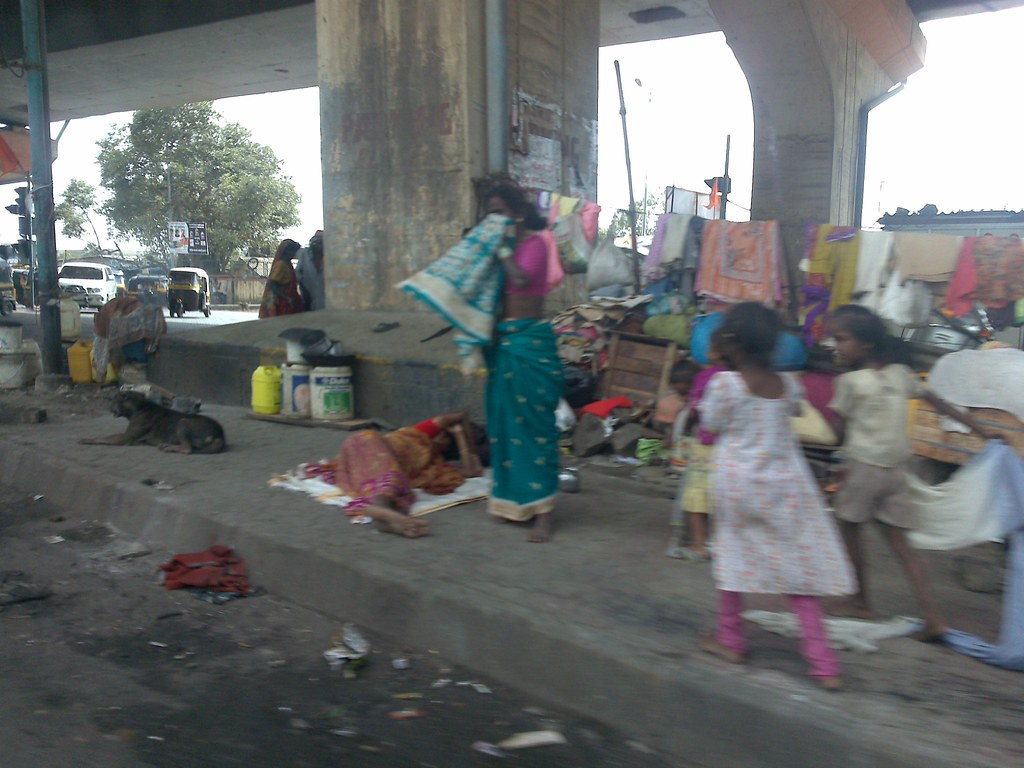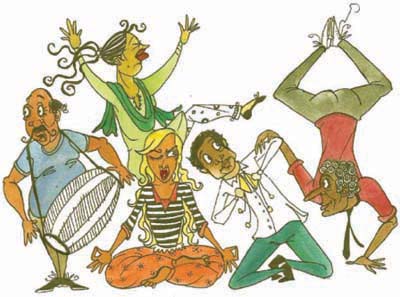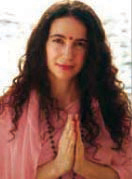- Home
- Archive -Dec 2010
- Let INDIA Insid. . .

Let INDIA Inside You
- In :
- Personal Growth
December 2010
By Sadhvi Bhagvati
Once it has entered our being, whether we invited it or not, once it has held up the mirror of ourselves to ourselves, once it has turned us upside down and inside out, then and only then has India showed us India
 |
If one more person pushes and squeezes me in the aarti again I’m going to scream!” The tears in her eyes are testimony to the very real and sincere pain this young woman from London is experiencing. To an Indian this pain is unfathomable. Pushing and squeezing are part and parcel of the Indian way of life and the spiritual sector isn’t an exception. Overcrowding is not, in these cases, the reason, for there is plenty of room if one is only prepared to be a little farther from the centre of the action.
The reason touches upon something much deeper and more profound in the culture of India. It also illustrates why visits to India, particularly spiritual pilgrimages, are so emotionally difficult for people from other countries.
After living in India for nearly 15 years, I have realised that there is absolutely no concept of social space here the way we understand it in the West. This is neither a good thing nor a bad thing. It just is. In the West, there is an unspoken but universally understood buffer zone around each of us, physically and emotionally, which can be trespassed upon only by intimate friends and relations. If two people who are standing and speaking with each other start to get too physically close (unless of course there is romance brewing) an invisible yet almost tangible magnet will pull them backwards until the comfortable social distance is re-established.
 Sadhvi Bhagawati Saraswati, PhD, Sadhvi Bhagawati Saraswati, PhD,is an American Stanford graduate who has taken sanyas from Pujya Swami Chidanand Saraswatiji and has been living at Parmarth Niketan Ashram in Rishikesh, India, for nearly 15 years. |
In India, this is not the case. If two people are sitting next to each other, with a socially comfortable five or six inches of space between them, that space counts as a ‘seat’. An Indian could very easily squeeze him/herself into that spot with absolutely no sense of having committed a social faux-pas. I cannot say how many times someone has come and sat down basically on my lap in a variety of religious functions in halls, temples and elsewhere. “But how in the world did a voluptuous, well-endowed woman think there was room to sit down in six inches of space?” I used to wonder. “Didn’t she realise she’d be sitting on my legs?” Of course, she realised. The difference is that to her there’s nothing wrong with it, if she’s Indian. My legs, my lap, my personal space are absolutely viable options for places to sit.
No personal space
The same is true emotionally. “Are you married? Why aren’t you married? How come your parents let you come to India? Don’t they want you to get married? How much money do you make? Are your brothers and sisters married? How much money do they make?” The questions flow out in a fast stream, like a waterfall upon an unsuspecting bather who went into a pond for a relaxing dip, not realising what was about to rain down upon his head. The look of bewilderment, of insult, of embarrassment on the face of the questioned doesn’t seem to deter the questions either. For, again, there is no personal/social space they have invaded. It just doesn’t exist.
This is where the choice comes for Westerners visiting India or living in India. We have two options. Either we can try to turn India into America or Europe and attempt to impose our standards and cultural norms upon India or we can let India be India and open ourselves to the transformation which is possible. The former is what we normally do, but it is an exercise in futility and frustration. The latter is where the real possibility of India manifests.
India is not a country which can be seen at an arm’s distance. To try to hold India at an arm’s distance is about as effective as holding up a stop-sign at an approaching tsunami. You’re going to get wet, stop-sign in hand or no stop-sign in hand. And that’s the beauty of India. India does not show us India from the outside. It’s not about the buildings or the sights. Yes, of course, these are beautiful and interesting, but they’re not India in terms of what India has to give. They can just as easily be seen in postcards.
India shows us India not in bricks, not in cement, not even in mud or thatch, but India shows us India only from the inside. Once it has entered our being, whether we invited it or not, once it has held up the mirror of ourselves to ourselves, once it has brought out both the very worst and also the very best in us (sometimes alternating almost comically in a period of merely minutes or hours), once it has turned us upside down and inside out, then and only then has India showed us India.
Inside India
Europe can be held at a distance. One can visit Europe, enjoy Europe and ‘see’ Europe by visiting the various cities and countrysides, by visiting the cathedrals and ancient ruins, by sipping coffee in a road side cafe and eating baguettes and brie on park benches in the shade.
But India wants to get inside. And it will, for our own benefit. If medicines were unable to penetrate the cell wall, if they were unable to get deep within our cells and spill its contents there, it would be unable to help us.
In the same way, India is meant to heal us. But only from the inside. Only if it can penetrate the walls. Only if we let it in.
When I first came to India I decided almost immediately that I would wear sarees. Many people tried to dissuade me by telling me how difficult it is to tie a saree, but I decided that if half a billion people (approximately 50 per cent of the population of India is women), most of whom were uneducated, could figure it out, it couldn’t be so complex. Hence, I started wearing sarees, and I wore them poorly at first. So poorly, in fact, that every time I wandered around outside of the ashram, random women would come up to me, stick their hands into my saree, grab the place where the pleats get tucked into the petticoat, and – with a few sharp tugs – pull my saree into proper place.
The first time it happened, I remember thinking, “Oh my God. That woman just stuck her hands into my underwear.” And I didn’t even know her. But then I stopped and I realised there was another way of looking at this. Rather than thinking that a random, unknown woman had just violated my personal space in a very significant way, I could also think, “Wow. That woman just did for me exactly what she would have done for her own daughter. That woman on the street just adopted me.” Suddenly, rather than being violated, I had been adopted. Day after day after day by woman after woman, until I finally learned to tie my sarees correctly. The number of Indian women who adopted me in that way is uncountable.
One-world family
India is a country where everyone is a family relation. Uncle, aunty, bhai and behen are ubiquitous suffixes to everyone’s name. So a new woman we meet, older than ourselves, is not just Vinita or Vinitaji, but rather she is Vinita aunty. A new man we meet of a similar age to ourselves is not just Vinod, but rather he is Vinod bhai. The concept of Vasudeva kutumbhakam or the world is one family is not merely a trite platitude. It is truly the way India operates. If she’s my aunty and I’m her niece then there’s nothing wrong with her sitting half-way into my lap. If she is mataji and thus I am her daughter, then, of course, she can put her hands in my underwear to fix my saree.
So, when someone sits down on top of our legs because he/she has decided that the five inches of space next to us is enough to squeeze into, or when someone places their bags, or their baby, on our lap as though we were a shelf, or when someone asks us questions more personal than we’d comfortably tell our own therapist, let us pause for a moment and realise we have a choice. We have either been violated or we’ve been adopted. The choice is up to us, and the outcome of our trip to India – whether it was heart-opening and transformative in a beautiful and divine way, or whether it was frustrating, infuriating and nerve-wracking, bears direct correlation to which choice we make. Violated or adopted? What other country offers such a choice?
To read more such articles on personal growth, inspirations and positivity, subscribe to our digital magazine at subscribe here
Life Positive follows a stringent review publishing mechanism. Every review received undergoes -
- 1. A mobile number and email ID verification check
- 2. Analysis by our seeker happiness team to double check for authenticity
- 3. Cross-checking, if required, by speaking to the seeker posting the review
Only after we're satisfied about the authenticity of a review is it allowed to go live on our website
Our award winning customer care team is available from 9 a.m to 9 p.m everyday
The Life Positive seal of trust implies:-
-
Standards guarantee:
All our healers and therapists undergo training and/or certification from authorized bodies before becoming professionals. They have a minimum professional experience of one year
-
Genuineness guarantee:
All our healers and therapists are genuinely passionate about doing service. They do their very best to help seekers (patients) live better lives.
-
Payment security:
All payments made to our healers are secure up to the point wherein if any session is paid for, it will be honoured dutifully and delivered promptly
-
Anonymity guarantee:
Every seekers (patients) details will always remain 100% confidential and will never be disclosed
